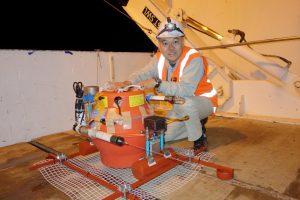
Slow earthquakes such as slow slips are drawing the attention of researchers due to their potential connection to tsunami earthquakes.
An international team of seismologists recorded a slow slip event in a shallow area of plate boundary at the Hikurangi margin off the northeast shore of New Zealand, showing for the first time that such slippage can occur near troughs. This implies that subduction plates may be accumulating much more stress and strain than previously believed –before they bounce back to set off tsunami earthquakes.
Authors say that the finding, published May 6, 2016 in Science, helps assess earthquake occurrence risk in coastal areas near subduction zones, especially at locations of shallow depth. “Slow earthquakes on the plate interface increase stress on the foci of the large earthquakes, ultimately triggering the largest inter-plate earthquakes,” says study author Yoshihiro Ito of Kyoto University. “In fact, a slow slip event was recorded one month prior to the 2011 Tohoku-Oki Earthquake. When the main shock occurred, the plate slipped drastically about 30 meters, leading to the damaging tsunami.”
Slow slips last from a few days up to an entire year. Compared to normal earthquakes, deformation occurs at a much more gradual pace. In the Hikurangi Trough, the Pacific plate subducts beneath the continental plate at a rate of 3-6 cm per year. Slow slips occur in 18-24 month cycles in concert with subduction of the plate.
Some of the areas in which these slow slips occurred match the epicenter of the 1947 Gisborne Earthquakes. Tsunami earthquakes like these are accompanied by waves much larger in scale than would be expected from shaking originating on land. The results from the current study imply that slow slip regions’ seismic slips are just like any other earthquake, and that they also have the potential to become the epicenter of major tsunami earthquakes.
The team, named HOBITSS (Hikurangi Ocean Bottom Investigation of Tremor and Slow Slip), installed 24 seabed pressure gauges in the Hikurangi subduction margin in May 2014 and collected them in June 2015. A slow slip occurred in September 2014 and lasted for 10 days. Records from the seabed pressure gauges and GPS measurements on land indicated that the sea floor rose between 1.5 to 5.4 cm.
Ito elaborates that the current study revealed important clues about the role of seamounts on megathrust earthquakes. “We know that in places like the Japan Trench and the Nankai Trough, there are some seamounts that subduct beneath the landward plate. But whether these seamounts are megathrust culprits or whether they ameliorate slips was a mystery,” he says. “Since the locations of the slow slips and subducting seamounts don’t match, our current study suggests that ocean mountains play a barrier-like role when slow slips occur.”
“Submarine drilling is planned for 2018, in the area where we observed the current slow slip,” Ito adds. “In addition, there are also plans underway for drilling with Chikyu, Japan’s scientific drilling vessel for deep ocean research. We look forward to integrating geological and materials data from drilling with geodetic observation, which should lead us to a better understanding of the mechanisms underlying slow slips.”
Reference:
“Slow slip near the trench at the Hikurangi subduction zone, New Zealand”,Laura M. Wallace, Spahr C. Webb, Yoshihiro Ito, Kimihiro Mochizuki, Ryota Hino, Stuart Henrys, Susan Y. Schwartz, Anne F. Sheehan. DOI: 10.1126/science.aaf2349
Note: The above post is reprinted from materials provided by Kyoto University.










